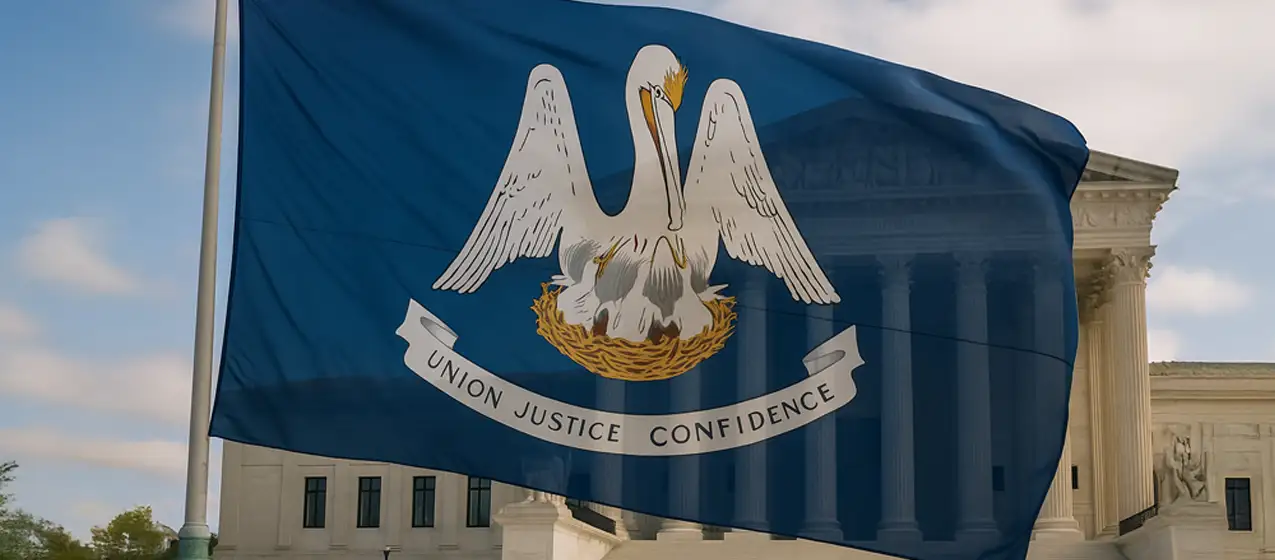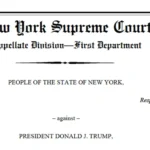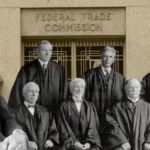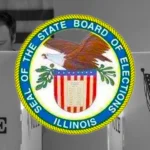
On October 15, the Supreme Court heard oral arguments in Louisiana v. Callais, a consolidated case on direct appeal from the U.S. District Court for the Western District of Louisiana. The Court is considering whether the Louisiana State Legislature’s drawing of a second majority-minority congressional district, enacted through Senate Bill 8 (S.B. 8), violates the Fourteenth and Fifteenth Amendments of the U.S. Constitution.
This case follows the ruling in Robinson v. Ardoin2, where Plaintiffs challenged a previous congressional map under Section 2 of the Voting Rights Act (VRA), alleging that it diluted the voting power of minority voters. For Callais, Appellants contend that the new district map created in S.B. 8 violates the Equal Protection Clause of the Fourteenth Amendment by using race as the priority factor in its formulation.
The S.B. 8 map was drawn under the framework established in Thornburg v. Gingles1—a test that, over time, has been interpreted with increasing flexibility. In Robinson v. Ardoin, the U.S. District Court for the Middle District of Louisiana applied the Gingles test and concluded that the State likely needed to create a second majority-minority district to remedy a Section 2 violation, emphasizing proportional racial representation as a key consideration.
Landmark Legal Foundation filed an amicus brief in support of Appellees—Phillip Callais and additional Louisiana voters. We argue that the Court’s current interpretation of Section 2 of the VRA3 on voter dilution claims and its application of the Gingles framework conflicts with the Fourteenth and Fifteenth Amendments. Furthermore, these Section 2-driven congressional maps clash directly with the Equal Protection Clause as race is the driving factor in drawing congressional maps.
Enacted in 1965, Section 2 of the VRA prohibits voting procedures that discriminate based on race, color, or language. While the statute originally targeted practices such as literacy tests and poll taxes, modern judicial interpretations have expanded Section 2 to the point of encroaching upon the constitutional guarantee of equal protection under the law. In Thornburg v. Gingles, North Carolina’s 1982 redistricting plan was challenged by black residents who argued that the newly drawn map impaired their ability to elect representatives of their choice, in violation of Section 2 of the VRA. The Court agreed, holding that the North Carolina maps violated Section 2 of the VRA and establishing the three-part test requiring Plaintiffs to show the following preconditions to permit redistricting (1) the minority group is sufficiently large and geographically compact; (2) the group is politically cohesive; and (3) the majority votes as a bloc to usually defeat the minority’s preferred candidate. These preconditions have opened the opportunity for states to redraw maps with race as the predominant factor. As Justice Thomas warned three decades ago, “[i]n construing the Act to cover claims of vote dilution, we have converted the Act into a device for regulating, rationing, and apportioning political power among racial and ethnic groups.”
Arguing on behalf of the Appellants, NAAP Legal Defense Fund lawyer Janai Nelson claimed that white Democrats are unlikely to vote for black candidates, a contention that can readily be rejected by examining electoral outcomes at the local, state, and federal levels across the United States. She also emphasized that Section 2 of the VRA is not in itself a remedy, but a tool for identifying when a remedy is warranted. Although this may be true, the court’s expansion of Section 2 to include vote dilution claims and the predominant racial factors implicated in Gingles has led to violations of the Fourteenth Amendment’s Equal Protection Clause.
In response, Hashim Mooppan and the other lawyers arguing in support of the Appellees argued that the Gingles test, as currently construed, “is not figuring out whether there’s an unfair effect based on race. It’s figuring out whether there’s an unfair effect based on party.” An interpretation that sharply departs from the text and purpose of Section 2 of the VRA. On this point, Mooppan drew an analogy between Louisiana and West Virginia: although West Virginia has zero Democratic districts, it has a large number of white Democrats. To this point, he argued, “[t]here’s just no reason to assume that because there’s a large Democratic population in Louisiana that doesn’t have a district, that that’s a racial reason rather than a partisan one. “
Justices Jackson and Sotomayor, both critical of the Appellee’s arguments, asserted that race should be a crucial factor in redistricting because of the nation’s history of racial discrimination. In making this point, Justice Jackson compared Section 2 of the VRA to the Americans with Disabilities Act (ADA), seeking to analogize Black Americans to individuals with disabilities. “The idea in Section 2 is that we are responding to current-day manifestations that disadvantage minorities and make so that they don’t have equal access to the voting system, right? They’re—they’re disabled.” Justice Sotomayor expanded on this reasoning, concluding that racial considerations in redistricting are necessary because, “you have some that—even white Republicans or white Democrats—won’t vote for black candidates.” An argument that many may view as grounded in a racial stereotype.
Justice Alito was critical of Louisiana’s illustrative map, noting that it was not geographically compact: “You have people from a rural area in the northwest part of the state, and you have people from an urban area many miles away combined in a district just for the purpose of getting over the 50 percent BVAP [black voting-age population].”
Justice Gorsuch suggested that equal protection jurisprudence does turn not on whether race predominates but on the broader principle that “we say you don’t discriminate on the basis of race, period.” He appeared unconvinced by the Appellants’ explanation that redrawing maps based on race is not intentional discrimination, remarking “that is choosing on the basis of race.”
Based on the majority of Justices’ seemingly receptive reactions to the Appellee’s argument that redistricting with race as a predominant factor violates the Equal Protection Clause, it appears likely that the Court will remand for stricter review. The Court could also refine or restrict the Gingles framework, narrowing the circumstances under which Section 2 of the VRA permits—or requires—race-conscious remedial districting. At a minimum, the Court could hold that race predominance in redistricting must pass strict scrutiny.
No matter how the Court rules, Landmark remains committed to fair elections and believes voters across the United States should have the opportunity to vote for the best candidate—not based on race or color, but on merit and commitment to public service.
SUPPORT LANDMARK LEGAL FOUNDATION
We are truly facing existential threats to our individual rights and liberties, the Constitution, and our national character. If unchallenged, this assault on our very way of life will ruin our great nation. With your financial and moral support, Landmark is not going to let that happen without a fight. Will you join us?
JOIN OUR MAILING LIST
Never miss an update from Landmark Legal Foundation as we continue the fight to preserve America’s principles and defend the Constitution from the radical left.





